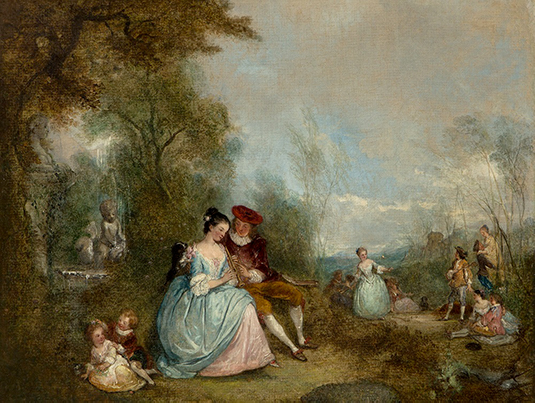
- Home Page
- Accepted
Paintings & Copies - Doubtful
Attributions - Doubtful Textual References
- Alternative
Titles - Collectors &
Museums - Bibliography
- Search Abecedario
- Watteau &
His Circle
X. Fête galante
Entered June 2020

Whereabouts unknown
Oil on canvas
65.5 x 78 cm
ALTERNATIVE TITLES
Höfische Gesellschaft
PROVENANCE
London, collection of Baron de Reuter; either Paul Julius, Baron de Reuter (1816-1899; founder of new agency) or his son, August Julius Clemens Herbert Reuter, 2nd Baron de Reuter (1852-1915; director of news agency).
Switzerland, private collection
Regensburg, Keup Kunstauktionen, April 13, 2010, lot 77: Jean -Antoine WATTEAU (Attrib.), Höfische Gesellschaft der Ideallandschaft bei Musikstunde und Ballspiel, est. €160,000. Bought in.
Vienna, Van Ham Kunstauktionen, May 13, 2011, lot 582: Circle of Jean Antoine Watteau / Fête Galante. Öl auf Leinwand. Doubliert. 65,5 x 78 cm. Rahmen. Oil on canvas laid on canvas Height 25.8 in.; Width 30.7 in. / Height 65.5 cm.; Width 78 cm. 35,000 – 40,000 EUR (37,293 – 42,621 USD). Bought in.
Berlin, Auctionata, November 29, 2013, lot 104: Jean Antoine Watteau, attributed—French Rococo Painter. Frame bearing a metal plaque with the name and life dates of Watteau. Verso various old labels including one inscribed ‘Provenienz Sammlung Baron de Reuter. Privatsammlung Schweiz. A typical ‘fête galante’ Amazing, partly reticulated hand carved wooden frame of the 19th century / Overall dimensions, framed 88 x 101 cm, . . . oil on canvas, relined / Height 43.6 in.; Width 39.8 cm.; Width 101. cm./ est. 15,000 – 15,000 EUR (20,405 – 20,405 USD). Bought in.
REMARKS
The four auctions in which this picture appeared between 2010 and 2013 and the increasingly lower estimates which were given reveal quite clearly the diminished hopes for this work being associated with Watteau’s name.
This pastiche of elements that look as though they were culled from Watteau cannot be attributed to any eighteenth-century artist. Rather, it seems to have been created by the nineteenth-century English artist George Henry Andrews (1816-1898), whose specialty was creating compositions in the style of Watteau. Often his pictures are filled with figures culled from specific Watteau compositions, as can be seen in our analysis of his Escarpolette. In this instance, however, the principal figures—the man teaching the woman to play a flute, the two children—prove too generic to be traced back to Watteau. There is no mistaking Andrews’ style: the doll-like figures and the rouged cheeks reveal his sentimental view of the ancient régime. The provenance from the Reuters family of London, attested to by a label on the reverse side of the picture, gains in significance once the painting is recognized to be by an English artist who also lived in London.